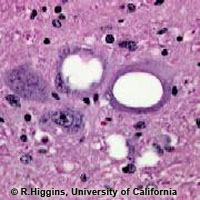Scientists slow scrapie in mice
Researchers in Germany have successfully slowed the progress of the fatal brain disease scrapie in mice. Scrapie, like Creutzfeld-Jakob disease (CJD) and BSE (Bovine Spongiform Encephalopathy), is a prion disease. Prions are a type of protein found throughout the body in healthy people and animals. These normal prions have a different shape to those associated with diseases. However, when normal prions come into contact with diseased prions, they change their shape, becoming 'diseased' themselves. In this way a chain reaction is sparked, as more and more normal prions become infected. These malformed prions are deposited in brain tissue, damaging it in the process. In this study, which is published in the latest issue of the Journal of Clinical Investigation, the researchers looked into the possibility of halting the chain reaction by stopping the production of normal prions. In mice the normal prion is called PrP-C, while the prion that causes scrapie is known as PrP-Scr. In order to see whether turning off PrP-C production would slow the spread of the disease, the team applied research which won its discoverers this year's Nobel Prize for Medicine: RNA interference. Small interfering RNA (siRNA) prevents the production of specific proteins by blocking the genes which code for them. The German researchers modified the brain cells of mice so that they produced siRNAs which blocked production of the healthy PrP-C prions. In cell cultures the production of PrP-C was reduced by 97%. The next challenge was to reproduce this in mice that had scrapie. 'If brain cells are to produce siRNAs, you have to smuggle in the corresponding gene,' explained Professor Hans Kretschmar, director of the Prion Centre at the Ludwig Maximilian University in Munich. However, getting the siRNA gene into every single brain cell would be extremely difficult, so the researchers also wanted to find out how many cells needed to be able to produce the siRNA for the treatment to be effective. They found that mice in which only a few brain cells were producing the siRNA died on average just a few days after untreated mice. However, mice in which the majority of brain cells were protected lived for up to 230 days, a third longer than untreated mice. 'Basically siRNAs seem to be a promising therapeutic option for scrapie, CJD or BSE,' said Professor Alexander Pfeifer, Director of the Institute of Pharmacology at the University of Bonn. 'However, it will take years before the method can be used on human beings.'
Countries
Germany



